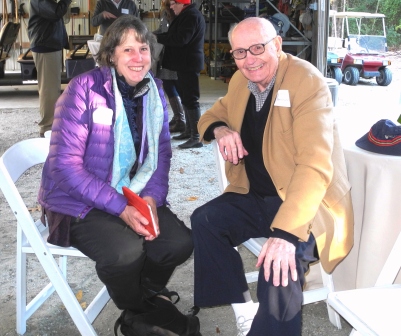Voted the Best Place to See by Condé Nast Traveler.

by Alison Rea
Drayton Hall appears bathed in afternoon light. Sitting patiently through time. Empty, but once bursting with long-gone lives one can only try to imagine. Except, at Drayton Hall, archaeologists and historians have been painstakingly piecing together an accurate picture of life from 1738, when the Palladian grand house was started, to the present.

Alison Rea, author and Drayton family descendant, sits with Charlie Drayton during the Backlot Celebration in November.
In November, I went to an event on the former plantation grounds that showed a range of findings that Drayton Hall has been assembling. Digital reconstructions of the original paint revealed the taste of the early 18th century that was not at all like the light pinks and blues with cream woodwork that a novice like me has come to expect of colonial times. Instead, John Drayton, the builder, chose a surprisingly modern neutral stone color for the walls with the stairs and associated woodwork a startlingly dark reddish color—that I was later told was mahogany stained with a crimson dye made from Cochineal bugs—a distinctive hue I most often associate with Persian rugs.
Most interesting to me was a room of pottery sherds from the beginning of habitation on the site. Sarah Stroud Clarke, Archaeologist at Drayton Hall, identified a few pottery sherds created by Native Americans, who I learned were some of the first and primary slaves in the area. Other artifacts on display were created later by enslaved natives and Africans as the two cultures merged. There were also early settler fragments of pottery imitating porcelain—then a worldwide endeavor. But perhaps most accessible to me was the lovely Chinese export saucer and cup fragments. Among the motifs were delicate gold and rose flowers and various birds.
I look forward to Drayton Hall having an interpretive center where everyone who visits can see what I got to see at this special exhibit and learn more about the time and place as I did. It was great.
About the Author
Alison Rea is a New York freelance writer/editor who has written for a number of organizations including The Economist Intelligence Unit (EIU), KPMG, and CFO Research Services. She was formerly U.S. Editor for Strategic Finance—an EIU quarterly serving top financial-services executives, Money and Banking Editor for Business Week, a reporter for Fortune, and U.S. Banking Correspondent for Reuters.
Alison is a descendant of John Drayton and the daughter of Elizabeth Drayton Taylor and Charles deVere Drayton. See Alison’s Family Tree for her lineage.